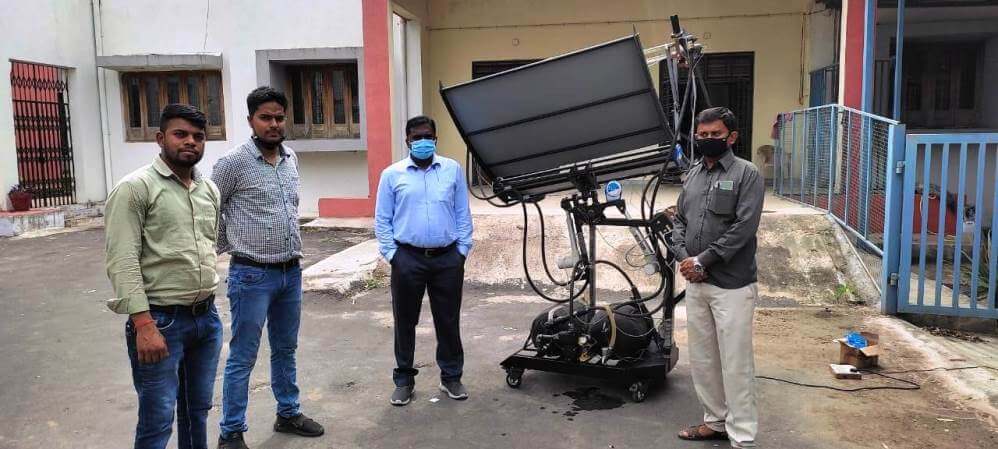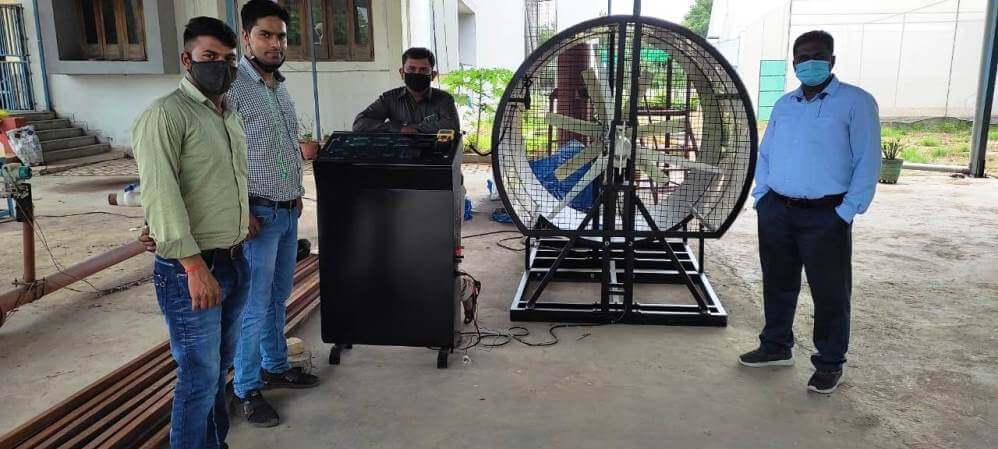Solar Thermal & Wind Energy Lab Installation at College of Agriculture Engineering and Technology, Godhra, Gujarat
Ecosense Installs Solar Thermal Parabolic Trough Collector based system and Wind Energy Training System in Department of Renewable Energy at College of Agriculture Engineering and Technology, Godhra, Gujarat.
Ecosense’s Solar Thermal Parabolic Trough Collector based Lab
Ecosense’s Solar Thermal Parabolic Trough Collector Based System consists of parabolic reflectors, absorber tube, sun tracker, piping, storage tanks and a heat exchanger. A control panel would control different devices and also measure the different parameters of the system. The system can be used to perform experiments in heat transfer, parabolic trough characteristics and heat loss at different parts of the system. The system is highly flexible – it can be used with different working fluids, different absorbing materials, different piping insulation thickness and different types of storage tanks. This gives a lot of scope for research in heat transfer and related fields. Wind speed variation and flow velocity are other parameters which can be changed to show their impact on heat transfer and heat loss.
Advantages of Ecosense’s Solar Thermal Parabolic Trough Collector based Lab
Ecosense’s Solar Parabolic Trough Training system enable students to learn about Solar thermal technologies in easy and interactive manner. It enables user to understand the following Solar thermal technology-based concepts:
• Basics on solar thermal Solar Parabolic Trough Collector technology
• Basic terminologies used for solar thermal technology like temperature, pressure, flow measurement installs collector/receiver mounting structures on the foundations
• Efficiency evaluation at different parts of the system
• Study the effect of change in parameters such as wind speed, irradiation and ambient temperature
• Measure and compare the pressure in various tubes with design values.

Fig. 1 Demonstration of Parabolic Trough system
Wind Energy Training System
Wind Energy Training System is a scaled down version of actual standalone Wind Turbine power plant. This system facilitates the students with working and configurable model of wind turbine. This system gives the insight about individual components and consequences of changing the operating points of any wind turbine defined in terms of wind speed and pitch angle. Students can learn concepts like I-V characteristic, cut-off, cut-in speed etc.
This system is developed such that it can work inside a closed laboratory with an artificial wind generating unit, which makes it weather proof. User can access and utilize the system capability at any time of the day without worrying about the actual climatic conditions. This system uses a big fan mounted on top of an Induction motor, the speed of which can be controlled by a Variable Frequency Drive. User can control the speed of motor which further controls the Wind speed using the Variable Frequency Drive. The variable wind speed prompts Wind Turbine to convert Wind Energy into Electrical energy and outputs three phase electrical output. The three-phase electrical output is connected with a three-phase rectifier which converts electrical output from AC to DC. The DC output is then further connected to a Charge controller and Battery. A DC load can be connected at Charge controller output. The Battery is further connected to a home inverter which provides clean useable AC electricity.
Advantages of Wind Energy Training System
Ecosense’s Wind Energy Training System enables students to learn about Wind Turbine technologies in easy and interactive manner. A user can study and understand about the following principles of Wind Energy Generation technology:
• Evaluation of efficiency of charge controller
• Evaluation of the cut-in speed of wind turbine experimentally
• Evaluation of Tip Speed ratio (TSR) at different wind speeds
• Evaluation of coefficient of performance of wind turbine
• Draw the turbine Power versus wind speed curve
• Draw the curve between TSR and coefficient of power
• Draw the power curve of turbine with respect to the rotational speed of rotor at fix wind speeds
• Demonstrate the power analysis at turbine output
• Demonstrate the power analysis at different branches of wind turbine energy system with AC load only
• Demonstrate the power analysis at different branches of wind turbine energy system with DC load only.

Fig. 2 Demonstration of Wind Energy Training System
Master’s Training Conducted
After successful installation of systems, a short 1-day master’s training program is conducted. This master’s training was focused on how to efficiently utilize the system in core-curriculum development and practical experimentations.
Program Outcomes
The faculty members and students really enjoyed our two-day training programme and loved to work on our lab equipment. Professors will further conduct experiments on the system to understand it more deeply and incorporate this lab set up as part of their regular curriculum.
